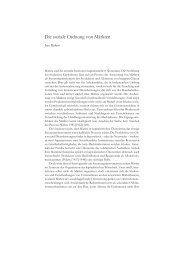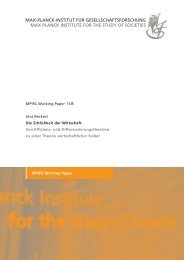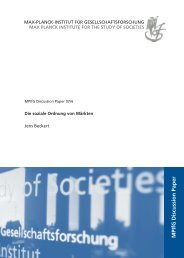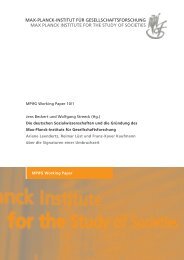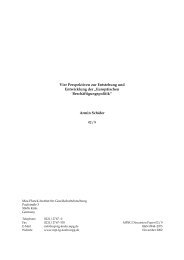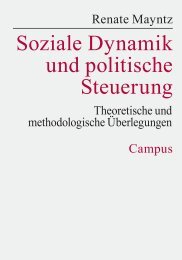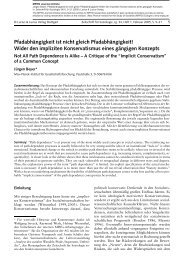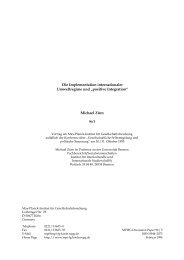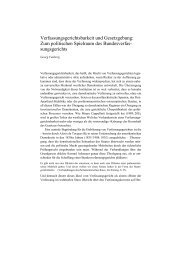- Seite 2 und 3:
Renate Mayntz, Wolfgang Streeck (Hg
- Seite 6 und 7:
Inhalt Die Reformierbarkeit der Dem
- Seite 8 und 9:
Die Reformierbarkeit der Demokratie
- Seite 10 und 11:
Die Reformierbarkeit der Demokratie
- Seite 12 und 13:
Die Reformierbarkeit der Demokratie
- Seite 14 und 15:
Die Reformierbarkeit der Demokratie
- Seite 16 und 17:
Die Reformierbarkeit der Demokratie
- Seite 18 und 19:
Die Reformierbarkeit der Demokratie
- Seite 20 und 21:
Die Reformierbarkeit der Demokratie
- Seite 22 und 23:
Die Reformierbarkeit der Demokratie
- Seite 24 und 25:
Die Reformierbarkeit der Demokratie
- Seite 26 und 27:
Die Reformierbarkeit der Demokratie
- Seite 28:
Teil I Reformen und Innovationen
- Seite 31 und 32:
32 I · Reformen und Innovationen u
- Seite 33 und 34:
34 I · Reformen und Innovationen e
- Seite 35 und 36:
36 I · Reformen und Innovationen g
- Seite 37 und 38:
38 I · Reformen und Innovationen S
- Seite 39 und 40:
40 I · Reformen und Innovationen 3
- Seite 41 und 42:
42 I · Reformen und Innovationen f
- Seite 43 und 44:
44 I · Reformen und Innovationen a
- Seite 45 und 46:
46 I · Reformen und Innovationen 3
- Seite 47 und 48:
48 I · Reformen und Innovationen s
- Seite 49 und 50: 50 I · Reformen und Innovationen S
- Seite 51 und 52: 52 I · Reformen und Innovationen d
- Seite 53 und 54: 54 I · Reformen und Innovationen b
- Seite 55 und 56: 56 I · Reformen und Innovationen g
- Seite 57 und 58: 58 I · Reformen und Innovationen l
- Seite 59 und 60: 60 I · Reformen und Innovationen b
- Seite 61 und 62: 62 I · Reformen und Innovationen j
- Seite 63 und 64: 64 I · Reformen und Innovationen e
- Seite 65 und 66: 66 I · Reformen und Innovationen s
- Seite 67 und 68: 68 I · Reformen und Innovationen K
- Seite 69 und 70: 70 I · Reformen und Innovationen S
- Seite 71 und 72: 72 I · Reformen und Innovationen g
- Seite 73 und 74: 74 I · Reformen und Innovationen o
- Seite 75 und 76: 76 I · Reformen und Innovationen t
- Seite 77 und 78: 78 I · Reformen und Innovationen S
- Seite 79 und 80: 80 I · Reformen und Innovationen w
- Seite 81 und 82: 82 I · Reformen und Innovationen c
- Seite 83 und 84: 84 I · Reformen und Innovationen s
- Seite 85 und 86: 86 I · Reformen und Innovationen T
- Seite 87 und 88: 88 I · Reformen und Innovationen H
- Seite 89 und 90: 90 I · Reformen und Innovationen a
- Seite 91 und 92: 92 I · Reformen und Innovationen s
- Seite 93 und 94: 94 I · Reformen und Innovationen p
- Seite 95 und 96: 96 I · Reformen und Innovationen H
- Seite 97 und 98: 98 I · Reformen und Innovationen -
- Seite 102 und 103: Héritier · Containing Negative In
- Seite 104 und 105: Héritier · Containing Negative In
- Seite 106 und 107: Héritier · Containing Negative In
- Seite 108 und 109: Héritier · Containing Negative In
- Seite 110 und 111: Héritier · Containing Negative In
- Seite 112 und 113: Héritier · Containing Negative In
- Seite 114 und 115: Héritier · Containing Negative In
- Seite 116 und 117: Héritier · Containing Negative In
- Seite 118 und 119: Héritier · Containing Negative In
- Seite 120 und 121: Héritier · Containing Negative In
- Seite 123 und 124: On Democracy and “Public Interest
- Seite 125 und 126: 124 II · Politik und Demokratie in
- Seite 127 und 128: 126 II · Politik und Demokratie in
- Seite 129 und 130: 128 II · Politik und Demokratie in
- Seite 131 und 132: 130 II · Politik und Demokratie in
- Seite 133 und 134: 132 II · Politik und Demokratie in
- Seite 135 und 136: 134 II · Politik und Demokratie in
- Seite 137 und 138: 136 II · Politik und Demokratie in
- Seite 139 und 140: 138 II · Politik und Demokratie in
- Seite 141 und 142: 140 II · Politik und Demokratie in
- Seite 143 und 144: 142 II · Politik und Demokratie in
- Seite 145 und 146: 144 II · Politik und Demokratie in
- Seite 147 und 148: 146 II · Politik und Demokratie in
- Seite 149 und 150:
148 II · Politik und Demokratie in
- Seite 152 und 153:
Die »komplexe Demokratietheorie«
- Seite 154 und 155:
M.G. Schmidt · »Komplexe Demokrat
- Seite 156 und 157:
M.G. Schmidt · »Komplexe Demokrat
- Seite 158 und 159:
M.G. Schmidt · »Komplexe Demokrat
- Seite 160 und 161:
M.G. Schmidt · »Komplexe Demokrat
- Seite 162 und 163:
M.G. Schmidt · »Komplexe Demokrat
- Seite 164 und 165:
M.G. Schmidt · »Komplexe Demokrat
- Seite 166 und 167:
M.G. Schmidt · »Komplexe Demokrat
- Seite 168 und 169:
M.G. Schmidt · »Komplexe Demokrat
- Seite 170 und 171:
M.G. Schmidt · »Komplexe Demokrat
- Seite 172 und 173:
M.G. Schmidt · »Komplexe Demokrat
- Seite 174 und 175:
Der Begriff der Verhandlungsdemokra
- Seite 176 und 177:
Czada · Verhandlungsdemokratie und
- Seite 178 und 179:
Czada · Verhandlungsdemokratie und
- Seite 180 und 181:
Czada · Verhandlungsdemokratie und
- Seite 182 und 183:
Czada · Verhandlungsdemokratie und
- Seite 184 und 185:
Czada · Verhandlungsdemokratie und
- Seite 186 und 187:
Czada · Verhandlungsdemokratie und
- Seite 188 und 189:
Czada · Verhandlungsdemokratie und
- Seite 190 und 191:
Czada · Verhandlungsdemokratie und
- Seite 192 und 193:
Czada · Verhandlungsdemokratie und
- Seite 194 und 195:
Czada · Verhandlungsdemokratie und
- Seite 196 und 197:
Czada · Verhandlungsdemokratie und
- Seite 198 und 199:
Czada · Verhandlungsdemokratie und
- Seite 200 und 201:
Czada · Verhandlungsdemokratie und
- Seite 202 und 203:
Czada · Verhandlungsdemokratie und
- Seite 204 und 205:
Czada · Verhandlungsdemokratie und
- Seite 206 und 207:
Konstruktive Vetospieler in Mehrebe
- Seite 208 und 209:
Benz · Konstruktive Vetospieler in
- Seite 210 und 211:
Benz · Konstruktive Vetospieler in
- Seite 212 und 213:
Benz · Konstruktive Vetospieler in
- Seite 214 und 215:
Benz · Konstruktive Vetospieler in
- Seite 216 und 217:
Benz · Konstruktive Vetospieler in
- Seite 218 und 219:
Benz · Konstruktive Vetospieler in
- Seite 220 und 221:
Benz · Konstruktive Vetospieler in
- Seite 222 und 223:
Benz · Konstruktive Vetospieler in
- Seite 224 und 225:
Benz · Konstruktive Vetospieler in
- Seite 226 und 227:
Benz · Konstruktive Vetospieler in
- Seite 228 und 229:
Benz · Konstruktive Vetospieler in
- Seite 230 und 231:
Benz · Konstruktive Vetospieler in
- Seite 232 und 233:
Benz · Konstruktive Vetospieler in
- Seite 234 und 235:
Benz · Konstruktive Vetospieler in
- Seite 236 und 237:
Benz · Konstruktive Vetospieler in
- Seite 238:
Teil IV Föderalismus und Unitarism
- Seite 241 und 242:
240 IV · Föderalismus und Unitari
- Seite 243 und 244:
242 IV · Föderalismus und Unitari
- Seite 245 und 246:
244 IV · Föderalismus und Unitari
- Seite 247 und 248:
246 IV · Föderalismus und Unitari
- Seite 249 und 250:
248 IV · Föderalismus und Unitari
- Seite 251 und 252:
250 IV · Föderalismus und Unitari
- Seite 253 und 254:
252 IV · Föderalismus und Unitari
- Seite 255 und 256:
254 IV · Föderalismus und Unitari
- Seite 257 und 258:
256 IV · Föderalismus und Unitari
- Seite 259 und 260:
258 IV · Föderalismus und Unitari
- Seite 261 und 262:
260 IV · Föderalismus und Unitari
- Seite 263 und 264:
262 IV · Föderalismus und Unitari
- Seite 265 und 266:
264 IV · Föderalismus und Unitari
- Seite 267 und 268:
266 IV · Föderalismus und Unitari
- Seite 269 und 270:
268 IV · Föderalismus und Unitari
- Seite 271 und 272:
270 IV · Föderalismus und Unitari
- Seite 273 und 274:
272 IV · Föderalismus und Unitari
- Seite 275 und 276:
274 IV · Föderalismus und Unitari
- Seite 277 und 278:
276 IV · Föderalismus und Unitari
- Seite 279 und 280:
278 IV · Föderalismus und Unitari
- Seite 281 und 282:
280 IV · Föderalismus und Unitari
- Seite 283 und 284:
282 IV · Föderalismus und Unitari
- Seite 285 und 286:
284 IV · Föderalismus und Unitari
- Seite 287 und 288:
286 IV · Föderalismus und Unitari
- Seite 289 und 290:
288 IV · Föderalismus und Unitari
- Seite 292 und 293:
Komplexität und Policy-Forschung:
- Seite 294 und 295:
Schneider · Komplexität und Polic
- Seite 296 und 297:
Schneider · Komplexität und Polic
- Seite 298 und 299:
Schneider · Komplexität und Polic
- Seite 300 und 301:
Schneider · Komplexität und Polic
- Seite 302 und 303:
Schneider · Komplexität und Polic
- Seite 304 und 305:
Schneider · Komplexität und Polic
- Seite 306 und 307:
Schneider · Komplexität und Polic
- Seite 308 und 309:
Schneider · Komplexität und Polic
- Seite 310 und 311:
Schneider · Komplexität und Polic
- Seite 312 und 313:
Schneider · Komplexität und Polic
- Seite 314 und 315:
Schneider · Komplexität und Polic
- Seite 316 und 317:
Literatur Schneider · Komplexität
- Seite 318 und 319:
Schneider · Komplexität und Polic
- Seite 320 und 321:
V. Schmidt · The Boundaries of “
- Seite 322 und 323:
V. Schmidt · The Boundaries of “
- Seite 324 und 325:
V. Schmidt · The Boundaries of “
- Seite 326 und 327:
V. Schmidt · The Boundaries of “
- Seite 328 und 329:
V. Schmidt · The Boundaries of “
- Seite 330 und 331:
V. Schmidt · The Boundaries of “
- Seite 332 und 333:
V. Schmidt · The Boundaries of “
- Seite 334 und 335:
V. Schmidt · The Boundaries of “
- Seite 336 und 337:
V. Schmidt · The Boundaries of “
- Seite 338 und 339:
V. Schmidt · The Boundaries of “
- Seite 340 und 341:
V. Schmidt · The Boundaries of “
- Seite 342 und 343:
V. Schmidt · The Boundaries of “
- Seite 344 und 345:
V. Schmidt · The Boundaries of “
- Seite 346 und 347:
V. Schmidt · The Boundaries of “
- Seite 348 und 349:
V. Schmidt · The Boundaries of “
- Seite 350 und 351:
V. Schmidt · The Boundaries of “
- Seite 352 und 353:
Fritz W. Scharpf · Wissenschaftlic
- Seite 354 und 355:
Fritz W. Scharpf · Wissenschaftlic
- Seite 356 und 357:
Fritz W. Scharpf · Wissenschaftlic
- Seite 358 und 359:
Fritz W. Scharpf · Wissenschaftlic
- Seite 360 und 361:
Fritz W. Scharpf · Wissenschaftlic
- Seite 362 und 363:
Fritz W. Scharpf · Wissenschaftlic
- Seite 364 und 365:
Fritz W. Scharpf · Wissenschaftlic
- Seite 366 und 367:
Fritz W. Scharpf · Wissenschaftlic
- Seite 368:
Fritz W. Scharpf · Wissenschaftlic


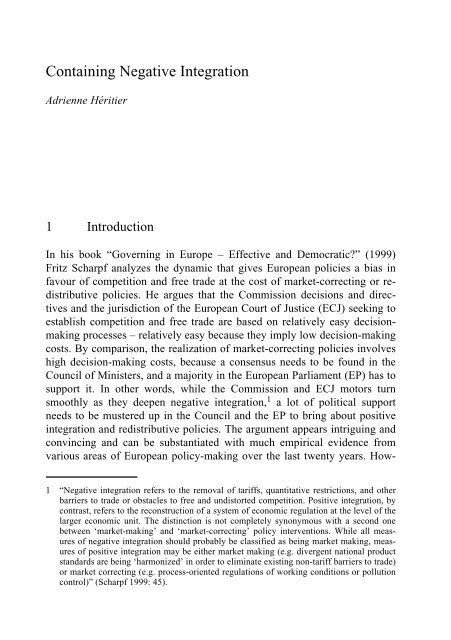
![PDF [0,9 MB] - MPIfG](https://img.yumpu.com/7494952/1/182x260/pdf-09-mb-mpifg.jpg?quality=85)

